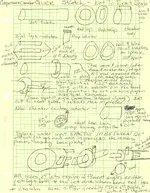The following was copied from Gould Engineering:
"The design of the venturi generator is completely different from any other device. The actual jet is located at 360 degrees around the outside of the incoming water from the suction hose. The concept is to grab the outer perimeter of the water from the suction hose, and break the surface tension on the wall of the tube and accelerate the body of water and material. The losses in this type of jet are very minimal. Because the jet gap is so small, the jets are usually made adjustable for maximum efficiency. This has a built in advantage, if the gap was to get clogged, then it could be opened to self-clean."
"The benefit is operating with smaller motors & pumps or eliminating one motor & pump, where two are needed to complete the job. The extra motor and pump are also very heavy when you have to pack it in to a remote spot. Another benefit is you will use less gas, for those of you that had to pack in your gas a long way from the road. There is one conclusion that I have arrived at with all this testing, there is a minimum size pump & motor that can be used to produce the venturi, after that size is met, the improved jets just produce more vacuum for a given size pump system."
"The test setup was very simple, a short piece of pipe with a vacuum port venmturi was installed at 90 degrees to the suction side of the Log and a 15.0' length of Suction Hose was attached to the other end. A Vacuum Gauge was connected to the vacuum port. A water pump, capable of producing 225 GPM, was attached to the water supply Jet of the Log. The pump was operated at half throttle and then full throttle, and each reading recorded. The full throttle data produced the best-controlled data, so that is what will be reported on. Why was a Vacuum Gage used instead of using a Calibrated Hand? I thought empirical data would best be derived at by using a Scientific Instrument, over the Calibrated Hand approach. The average reading was 4.0 inches of vacuum at full throttle. An interesting thing was found when I testing the Log, I decided to extend the length of the Log by various amounts and record the results. By extending the length of the Log by 12", the Vacuum would be increased by 1.0" of vacuum, for a total of 5.0" inches of vacuum, or an improvement of 25%. Why would increasing the length of the Log provide more suction? It is the nature of the beast, the Venturi System derives the vacuum or suction by various pressure zones. I did not attempt to calculate the proper length. The original length was probably determined by trial and error. It will be noted that there was no appreciable difference from one manufacture to another, they all did what they were supposed to do."
"Why are vacuum measurements important and what do they mean? The various readings are used for a baseline to measure the differences from one device to another. The vacuum readings are directly proportional to the suction at the end of the nozzle."
"The 2nd. Device tested was an experimental Tri-Jet, it tested at 7.8 inches of vacuum, at full throttle for an increase of 95%. I understand that there is a smaller manufacture of dredges that installs his Tri-Jet in the Suction Hose located about 5.0' from the Dredge. The people using his equipment say that this installation greatly increases the Suction."
"The 3rd. Device was another Experimental Jet, called the Infinity Jet, that device measured 9.5 inches of vacuum for an increase of 137.5%. The 4th. Device tested was a real shock, it was the old fashioned Suction Nozzle and it tested at 6.7 inches of vacuum, for an increase of 67.5% more power."



 ? got to do the math) to the jet. I may put a shut off zero loss shut off valve on one line to stop it from back flowing.
? got to do the math) to the jet. I may put a shut off zero loss shut off valve on one line to stop it from back flowing.
